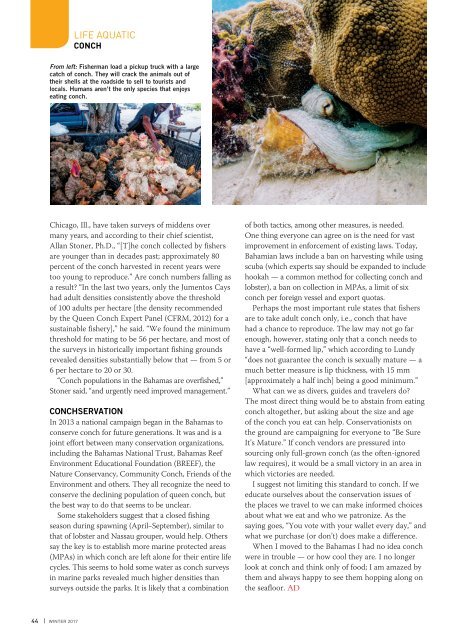AD 2017 Q1
Alert Diver is the dive industry’s leading publication. Featuring DAN’s core content of dive safety, research, education and medical information, each issue is a must-read reference, archived and shared by passionate scuba enthusiasts. In addition, Alert Diver showcases fascinating dive destinations and marine environmental topics through images from the world’s greatest underwater photographers and stories from the most experienced and eloquent dive journalists in the business.
Alert Diver is the dive industry’s leading publication. Featuring DAN’s core content of dive safety, research, education and medical information, each issue is a must-read reference, archived and shared by passionate scuba enthusiasts. In addition, Alert Diver showcases fascinating dive destinations and marine environmental topics through images from the world’s greatest underwater photographers and stories from the most experienced and eloquent dive journalists in the business.
You also want an ePaper? Increase the reach of your titles
YUMPU automatically turns print PDFs into web optimized ePapers that Google loves.
LIFE AQUATIC<br />
CONCH<br />
From left: Fisherman load a pickup truck with a large<br />
catch of conch. They will crack the animals out of<br />
their shells at the roadside to sell to tourists and<br />
locals. Humans aren’t the only species that enjoys<br />
eating conch.<br />
Chicago, Ill., have taken surveys of middens over<br />
many years, and according to their chief scientist,<br />
Allan Stoner, Ph.D., “[T]he conch collected by fishers<br />
are younger than in decades past; approximately 80<br />
percent of the conch harvested in recent years were<br />
too young to reproduce.” Are conch numbers falling as<br />
a result? “In the last two years, only the Jumentos Cays<br />
had adult densities consistently above the threshold<br />
of 100 adults per hectare [the density recommended<br />
by the Queen Conch Expert Panel (CFRM, 2012) for a<br />
sustainable fishery],” he said. “We found the minimum<br />
threshold for mating to be 56 per hectare, and most of<br />
the surveys in historically important fishing grounds<br />
revealed densities substantially below that — from 5 or<br />
6 per hectare to 20 or 30.<br />
“Conch populations in the Bahamas are overfished,”<br />
Stoner said, “and urgently need improved management.”<br />
CONCHSERVATION<br />
In 2013 a national campaign began in the Bahamas to<br />
conserve conch for future generations. It was and is a<br />
joint effort between many conservation organizations,<br />
including the Bahamas National Trust, Bahamas Reef<br />
Environment Educational Foundation (BREEF), the<br />
Nature Conservancy, Community Conch, Friends of the<br />
Environment and others. They all recognize the need to<br />
conserve the declining population of queen conch, but<br />
the best way to do that seems to be unclear.<br />
Some stakeholders suggest that a closed fishing<br />
season during spawning (April–September), similar to<br />
that of lobster and Nassau grouper, would help. Others<br />
say the key is to establish more marine protected areas<br />
(MPAs) in which conch are left alone for their entire life<br />
cycles. This seems to hold some water as conch surveys<br />
in marine parks revealed much higher densities than<br />
surveys outside the parks. It is likely that a combination<br />
of both tactics, among other measures, is needed.<br />
One thing everyone can agree on is the need for vast<br />
improvement in enforcement of existing laws. Today,<br />
Bahamian laws include a ban on harvesting while using<br />
scuba (which experts say should be expanded to include<br />
hookah — a common method for collecting conch and<br />
lobster), a ban on collection in MPAs, a limit of six<br />
conch per foreign vessel and export quotas.<br />
Perhaps the most important rule states that fishers<br />
are to take adult conch only, i.e., conch that have<br />
had a chance to reproduce. The law may not go far<br />
enough, however, stating only that a conch needs to<br />
have a “well-formed lip,” which according to Lundy<br />
“does not guarantee the conch is sexually mature — a<br />
much better measure is lip thickness, with 15 mm<br />
[approximately a half inch] being a good minimum.”<br />
What can we as divers, guides and travelers do?<br />
The most direct thing would be to abstain from eating<br />
conch altogether, but asking about the size and age<br />
of the conch you eat can help. Conservationists on<br />
the ground are campaigning for everyone to “Be Sure<br />
It’s Mature.” If conch vendors are pressured into<br />
sourcing only full-grown conch (as the often-ignored<br />
law requires), it would be a small victory in an area in<br />
which victories are needed.<br />
I suggest not limiting this standard to conch. If we<br />
educate ourselves about the conservation issues of<br />
the places we travel to we can make informed choices<br />
about what we eat and who we patronize. As the<br />
saying goes, “You vote with your wallet every day,” and<br />
what we purchase (or don’t) does make a difference.<br />
When I moved to the Bahamas I had no idea conch<br />
were in trouble — or how cool they are. I no longer<br />
look at conch and think only of food; I am amazed by<br />
them and always happy to see them hopping along on<br />
the seafloor. <strong>AD</strong><br />
44 | WINTER <strong>2017</strong>









